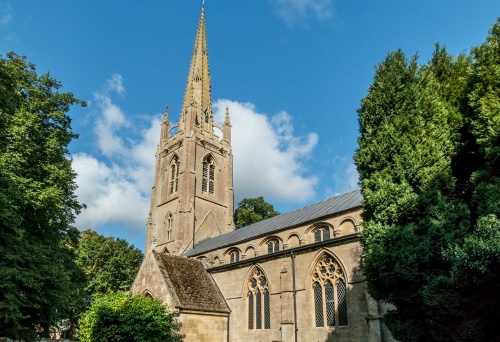
All Saints Church in the Lincolnshire village of Moulton is known locally as 'The Queen of the Fens'. This beautiful building was erected in 1180. It is possible that there was a much earlier Saxon church in Moulton, as a burial ground was discovered in 1789 during the construction of what is now the A151.
History
Historical records suggest that Thorold of Buckenhale, the Sheriff of Lincoln and the brother of Lady Godiva, had the right to appoint the parish priest at Moulton. Thorold granted that right to the Prior of Spalding and sometime between 1175 and 1190 Prior John of Spalding began building the present church at Moulton. He may have been trying to outdo the monks of Croyland Abbey, who were building the parish church of Whaplode at the same time.
Curiously, the parishioners of Moulton contributed to the cost of the new church, but Thomas de Multon, the largest landowner in the area, refused to do so. Multon refused to worship in the new church and decided instead to build his own chapel, where he held services without permission and allowed local residents to worship.
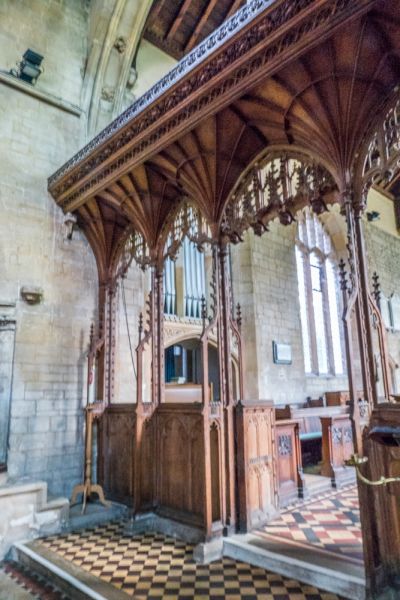
Not surprisingly, Thomas de Multon's actions brought him into conflict with Spalding Priory. The case went to the Pope, who sided with de Multon.
Over 80 years later another Thomas de Multon, a descendant of the first, and another Prior John of Spalding met at the church in Weston to sign a contract over the disposition of minor tithes and rent.
As for Prior John's church, it took 70 years to complete and consisted of a nave, chancel, and west tower. It measured 171 feet from east to west. It must have been an unruly place at times; in 1292 Bishop Oliver Sutton had to specifically ban markets and fairs in the churchyard and instead order the residents of Moulton to repair their bell tower.
The oldest part of the church is the east end of the nave, with its clustered pillars and circular benches at the base of each pillar. Each pillar has a corbel for resting the image of a saint. The capitals are intricately carved and feature small heads amongst the foliage.
The west end of the nave, by contrast, dates to the late 14th century and the carving is of a lower standard. Around 1310 the south aisle was widened and a decade later the north aisle followed. Only the north doorway was preserved.
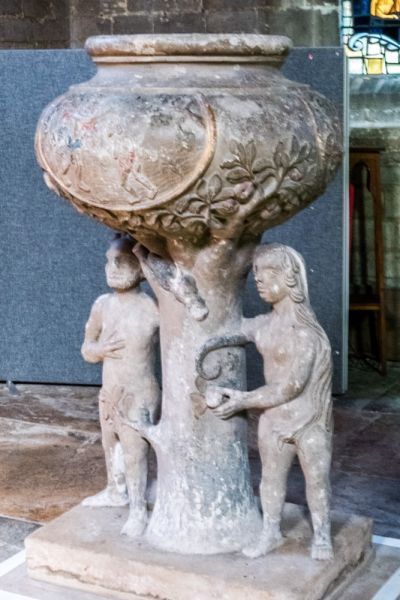
Wicked Statues
The west tower and spire date to around 1380. Around the belfry stage are two damaged statues and a niche for a central statue. according to local legend, the central statue was taken down because the unnamed person it depicted was known for his wickedness. The remaining two statues were mutilated in varying degrees according to the relative wickedness of the person represented.
It became something of a local challenge to climb to the top of the spire. One man named 'Ratty' Bailey climbed to the top of the spire and tied a red kerchief to it. The enterprising Bailey then climbed up again, retrieved his kerchief and sold pieces of it in the Swann Inn for 1/ each. There are six bells, the oldest cast in 1588.
There are clerestory windows to the north and south; the north windows were added earlier, and around 1400 the south windows were altered when the present timber roof was installed. There are piscinas at the east end of both aisles and at the west end of the south aisles, suggesting the presence of side altars in those locations.
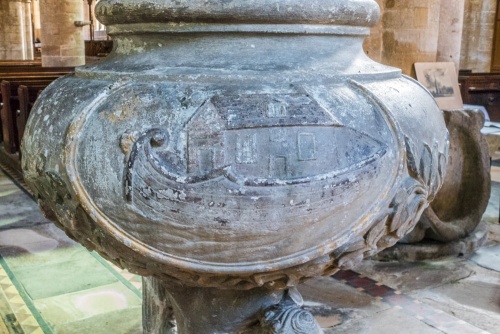
The chancel was rebuilt in the early 15th century but the east window glass dates to 1899 and was installed to commemorate Rev R Jackson, who acted as the Vicar of Moulton for 33 years. In the north wall of the sanctuary is an Easter Sepulchre and opposite, on the south wall, is a sedilia (seats for priests during services). On the wall is a memorial tablet to Rev John Chapman (d. 1763), while at the east end is a large memorial to generations of the Boulton family.
The Medieval Screen
One of the glories of Moulton Church is the 15th-century rood screen, carved around 1425. The screen is five bays wide, with the central bay forming the chancel entrance. The entrance gate is original 15th-century workmanship. Across the top of the screen is a beautifully carved wainscotting decorated with heads of beats, humans, foliage, a lion's head, birds, dragons, and two griffins.
The pulpit, reading desk, lectern and font are all products of the Victorian restoration. The pulpit appears to have been made from pieces of an old wardrobe. Close to the pulpit is a memorial to John Harrox (d. 1560). Harrox served as a steward to the Harrington family and he left money in his will to establish Moulton Grammar School. Near the Harrox memorial is a 16th-century communion table.
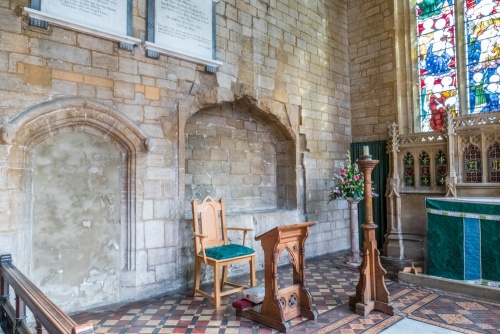
The Adam and Eve Font
All Saint's has no less than three fonts. The oldest is at the west end of the church and was reputedly lost for many years before it was rediscovered and returned to the church. The present font dates to the 1868 restoration. It is the third font, however, that draws your attention, and rightly so, as it is unlike anything I've seen in any other English church.
The font consists of a large, oval basin supported by a central column in the shape of a tree. A coiled serpent winds around the tree while on either side, supporting the basin, are figures of Adam and Eve. The font bowl is painted and decorated with branches laden with fruit and Eve is shown presenting Adam with an apple.
On the basin are depictions of Noah's Ark, with the figure of a dove being released. Other figures show a charioteer running down a pair of figures, while another scene shows two men, the larger with a sword threatening the smaller, who kneels before him. You can also make out the Baptism of Christ and the Parting of the Red Sea.
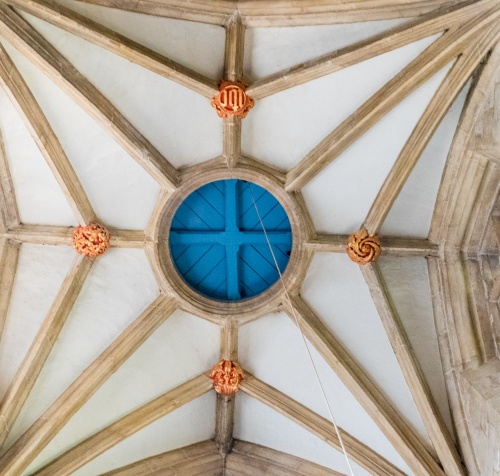
The 'Adam and Eve' font was installed in 1719 and was painted in the early 19th century. Both Adam and Eve were painted red; Adam was given dark hair and Eve painted with pale hair.
Unfortunately, the congregation objected to the painting and so much of it was scrubbed off. You can still clearly see traces of the original colour. Local tradition suggests that the font is based on a similar font is St James Church Piccadilly, London, designed by Grinling Gibbons.
A Curious Date
Near the Victorian font is a grave slab set into the floor, commemorating Prudence Corby, who died in 1793. Look closely at the date of Corby's death and you will see that the stonemason has carved 'July 36th'. as the church guidebook puts it, was the date 'a slip of the chisel or a sip too many?'
Visiting
All Saints is a delightful historic building, full of interest. It was open when we visited. The church is very easy to find; it is on the east side of High Street (the B1357) just south of Church Lane.
About Moulton, All Saints Church
Address: High Street,
Moulton,
Lincolnshire,
England, PE12 6QB
Attraction Type: Historic Church
Location: On the east side of High Street (B1357) in the centre of the village
Website: Moulton, All Saints Church
Location
map
OS: TF306241
Photo Credit: David Ross and Britain Express
POPULAR POSTS
HERITAGE
 We've 'tagged' this attraction information to help you find related historic attractions and learn more about major time periods mentioned.
We've 'tagged' this attraction information to help you find related historic attractions and learn more about major time periods mentioned.
Find other attractions tagged with:
NEARBY HISTORIC ATTRACTIONS
Heritage Rated from 1- 5 (low to exceptional) on historic interest
Moulton Windmill - 0.1 miles (Historic Building) ![]()
Pinchbeck Engine Museum - 3.1 miles (Museum) ![]()
Chain Bridge Forge - 3.5 miles (Museum) ![]()
Spalding, St Mary & St Nicholas Church - 3.7 miles (Historic Church)
Ayscoughfee Hall Museum & Gardens - 3.7 miles (Historic Building) ![]()
Gordon Boswell Romany Museum - 3.8 miles (Museum) ![]()
Croyland Abbey - 9.5 miles (Abbey) ![]()
Parson Drove, St John's Church - 10.7 miles (Historic Church) ![]()
Nearest Holiday Cottages to Moulton, All Saints Church:
More self catering near Moulton, All Saints Church



